[[{“value”:”
Goods deficits & Corporate America: Vietnam jumps to #3 on transshipments from China to dodge tariffs. Tiny Ireland jumps to #4 on trade invoicing to dodge US corporate income taxes.
By Wolf Richter for WOLF STREET.
The US trade deficit (exports minus imports) in goods and services in the year 2024 exploded by 17% from the prior year, to $918 billion, the second-worst year ever, behind only the 2022 deficit, according to trade data from the Census Bureau today.
The trade deficit in goods without services worsened in 2024 to a new all-time worst record, after a spike in December as Corporate America tried to front-run Trump’s tariffs. The small surplus in services improved, but was still smaller than in 2018 and 2019.
The trade deficit (“net exports”) is a negative for GDP. Exports are added to GDP, imports are subtracted from GDP. And this huge trade deficit has been the reason for decades why US economic growth hasn’t been better. For all of 2024, GDP grew by 2.8%, adjusted for inflation. It would have grown by 3.2% if trade had been balanced.
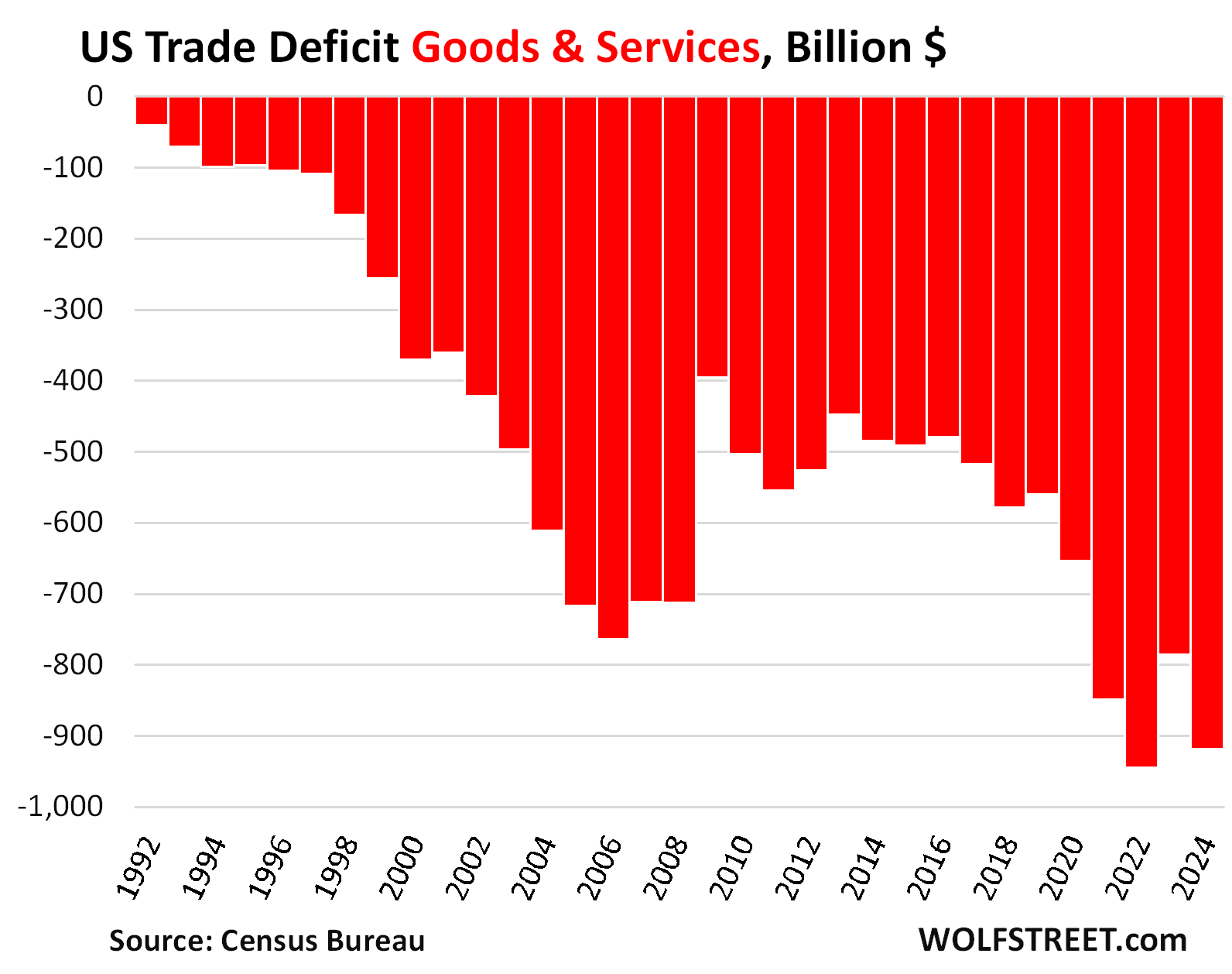
The goods trade deficit worsened by 14%, or by $148 billion, to a new All-Time Worst (ATW) of $1.21 trillion.
- Exports of goods ticked up by 1.9% (or by $39 billion) to $2.08 trillion, below 2022.
- Imports of goods worsened by 6% (or by $187 billion) to a new ATW of $3.30 trillion.
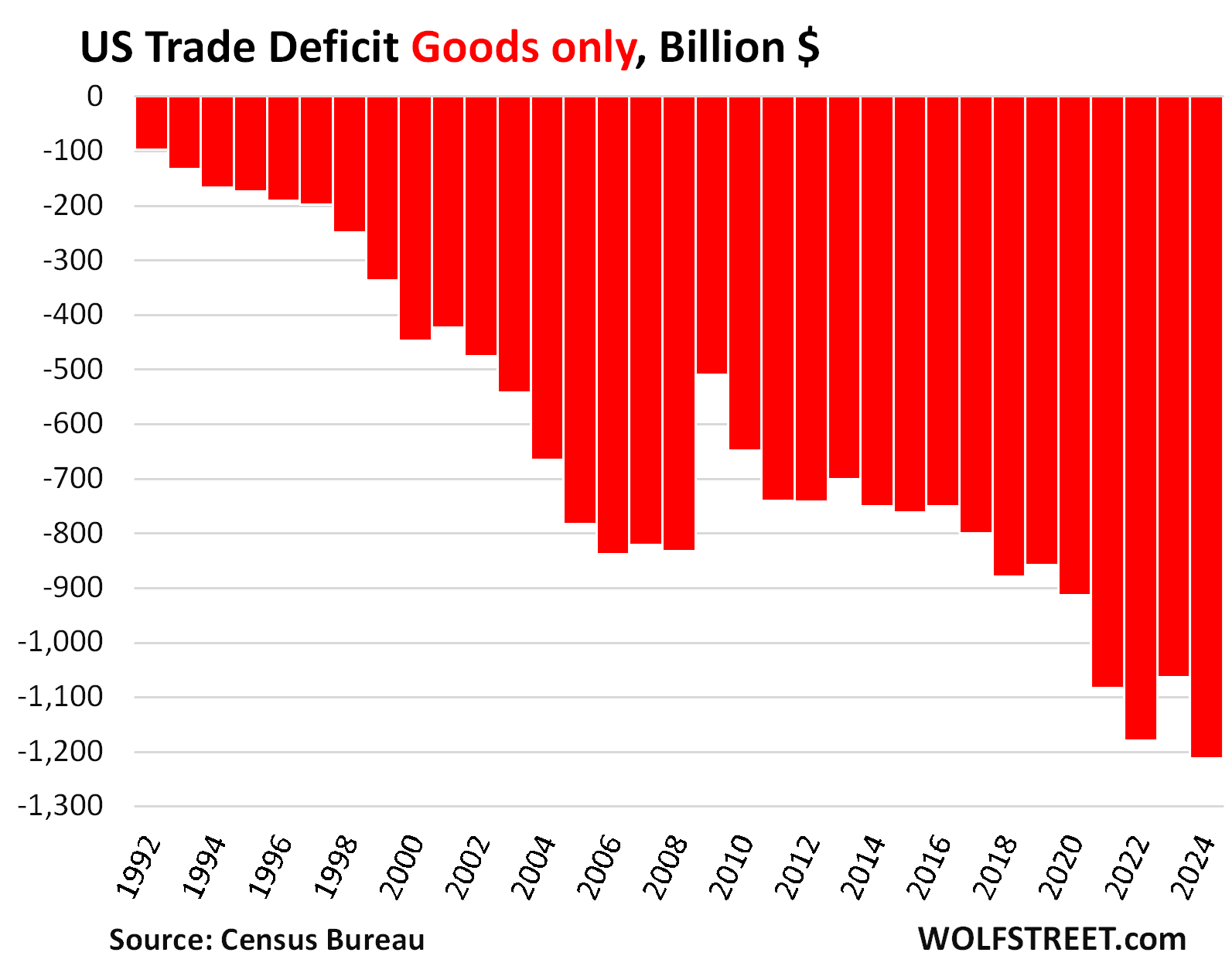
Three decades of connivance by the US government – which bridged with ease any political divide – and Corporate America, under the failed doctrine of globalization, have destroyed much of the manufacturing base so that corporate profit margins could fatten by chasing cheap labor, lax environmental laws, and preferential treatments in US and foreign tax codes.
In return, they sacrificed the most important economic sector – manufacturing – with its huge primary, secondary, and tertiary impact on employment, on household incomes, on federal, state, and local tax receipts, on knowhow in automation and manufacturing technology, on engineering and engineering education, and on infrastructure. In the process, they shifted much of this activity and expertise to other countries.
The US is still the second largest manufacturing country by output in the world, with a share of 15.9% of global manufacturing output, and larger than the next three combined – Japan 6.5%, Germany 4.8%, and India 2.9%. But China’s manufacturing output is nearly twice that of the US, with a share of 31.6% of global output (World Bank data).
That this mess was encouraged to happen over the past three-plus decades under the doctrine of “globalization” and “free trade” is a huge scandal that spanned the political parties. And those globalization-mongers are still at it today, preaching the same failed doctrine.
With China (incl. Hong Kong), the trade deficit in goods worsened in 2024 by 7%, to $273 billion. In reality, the trade deficit with China is much worse because a portion of the imports were routed through other countries, particularly Vietnam and Mexico (more in a moment), to bypass and subvert the tariffs imposed on goods from China in 2018 (more in a moment).
- Exports of goods to China worsened by 2.4% to $171 billion, fourth year in a row of declines.
- Imports of goods from China worsened by 3% to $445 billion.
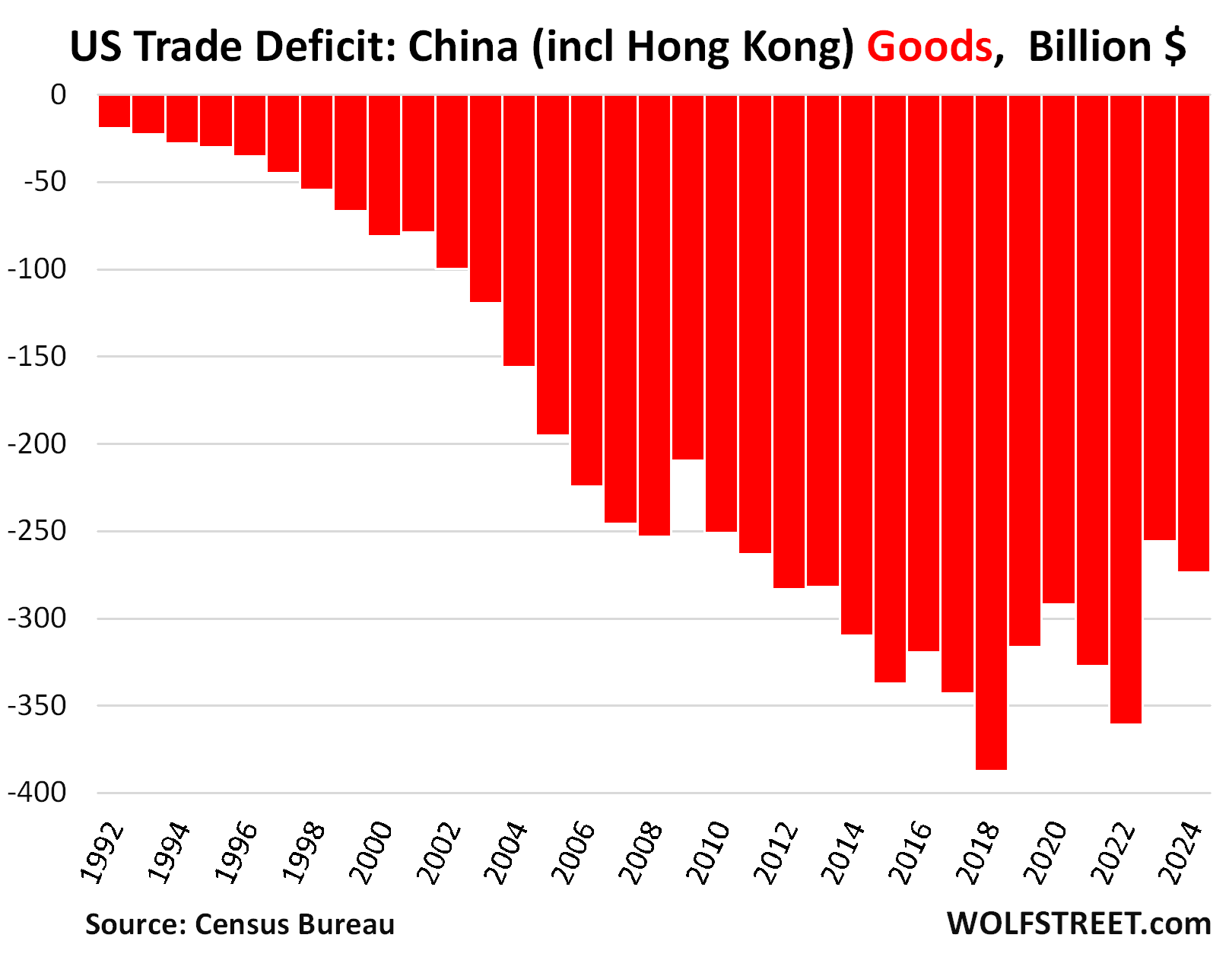
In overview: US goods exports (blue columns), US goods imports (black columns), and the resulting goods trade deficit of $1.21 trillion (red line):
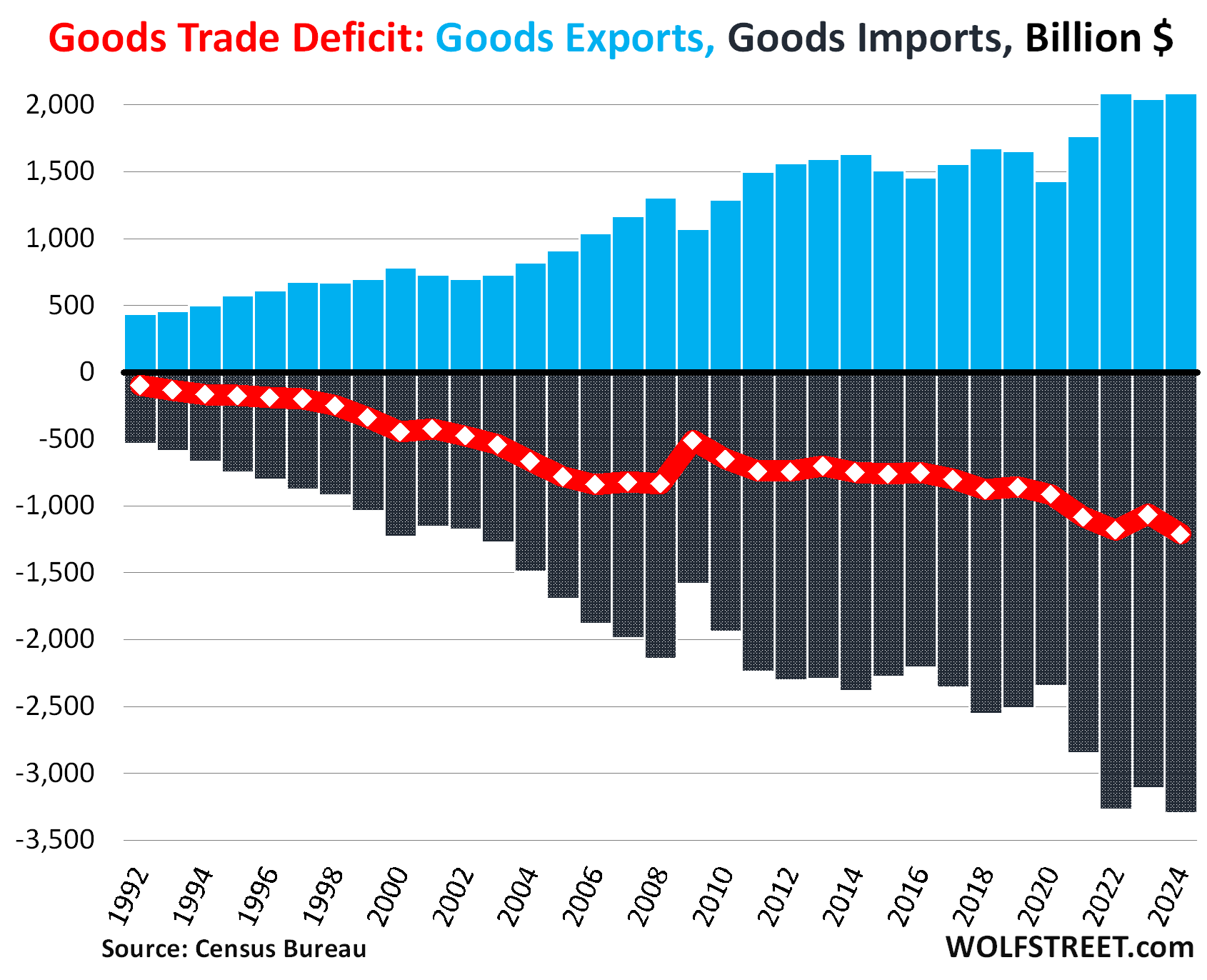
The services trade surplus rose by 5% (or by $15 billion) to $293 billion, below where it had been in 2018 and 2019.
Trade in services includes international tourism. Americans traveling overseas and spending US-earned money overseas on lodging, restaurants, tickets, etc., counts as imports of services. Foreign tourists, foreign students, foreign business people, etc. spending foreign-earned money in the US on lodging, restaurants, tuition, tickets, etc., counts as exports of services.
International travel slowed dramatically during the pandemic, which caused a big drop in both imports of services (Americans traveling overseas) and exports of services (foreigners traveling in the US). By 2022, most of the travel restrictions were lifted or loosened, and travel in both directions rebounded. 2023 was the year of “revenge travel,” and that trend continued in 2024, which caused the rebound in exports and imports of services.
- Exports of services (blue) rose by 7.9% (or by $81 billion) to a record $1.11 trillion.
- Imports of services (black) worsened by 8.9% (or by $66 billion), to $814 billion.
- As a result, the trade surplus in services (red line) rose but remained below 2018 and 2019.
This services surplus of $293 billion (red line) is dwarfed by the goods deficit of $1.21 trillion.

The US goods trade deficit, by country/region.
The opaque nature of international trade to dodge tariffs, US corporate income taxes, trade restrictions, etc., produces some curious effects.
Transshipments through third countries, such as from China through Vietnam, with minimal additional processing in Vietnam, allow Corporate America to dodge US tariffs. We see this in the ballooning trade deficit the US has with Vietnam: In 2024, it worsened by 18% to $123 billion; since 2019, following the tariffs on Chinese goods, Vietnam has shot up from nowhere to #3, behind China and Mexico
Chinese and US companies have been busy setting up shop in Mexico to use Mexico as entry point – such as by importing components from China and assembling them in Mexico and exporting the product to the US, to dodge tariffs on Chinese goods. The goods trade deficit with Mexico has continued to balloon and in 2024 shot up by another 12% to $172 billion.
Trade invoicing through third countries, such as those with low corporate income-tax rates, allow US corporations to dodge US corporate income taxes by keeping their profits in, for example, a mailbox entity in Ireland, and paying a lower corporate income tax on those profits in Ireland. This is why the goods trade deficits with Ireland continues to balloon, and in 2024 worsened by another 38%, to $87 billion, putting tiny Ireland in #4 position, ahead of export powerhouses Germany, Taiwan, and Japan.
The EU (yellow), an economic region some of whose members are also on this list, is closing in on China, as many imports originally from China are now showing up under Vietnam, Mexico, and other countries, including some European countries. The goods trade deficit with the EU worsened by 13% in 2024 to $235 million, a new ATW.
The 15 “trade partners” with which the US has the worst goods trade deficits.
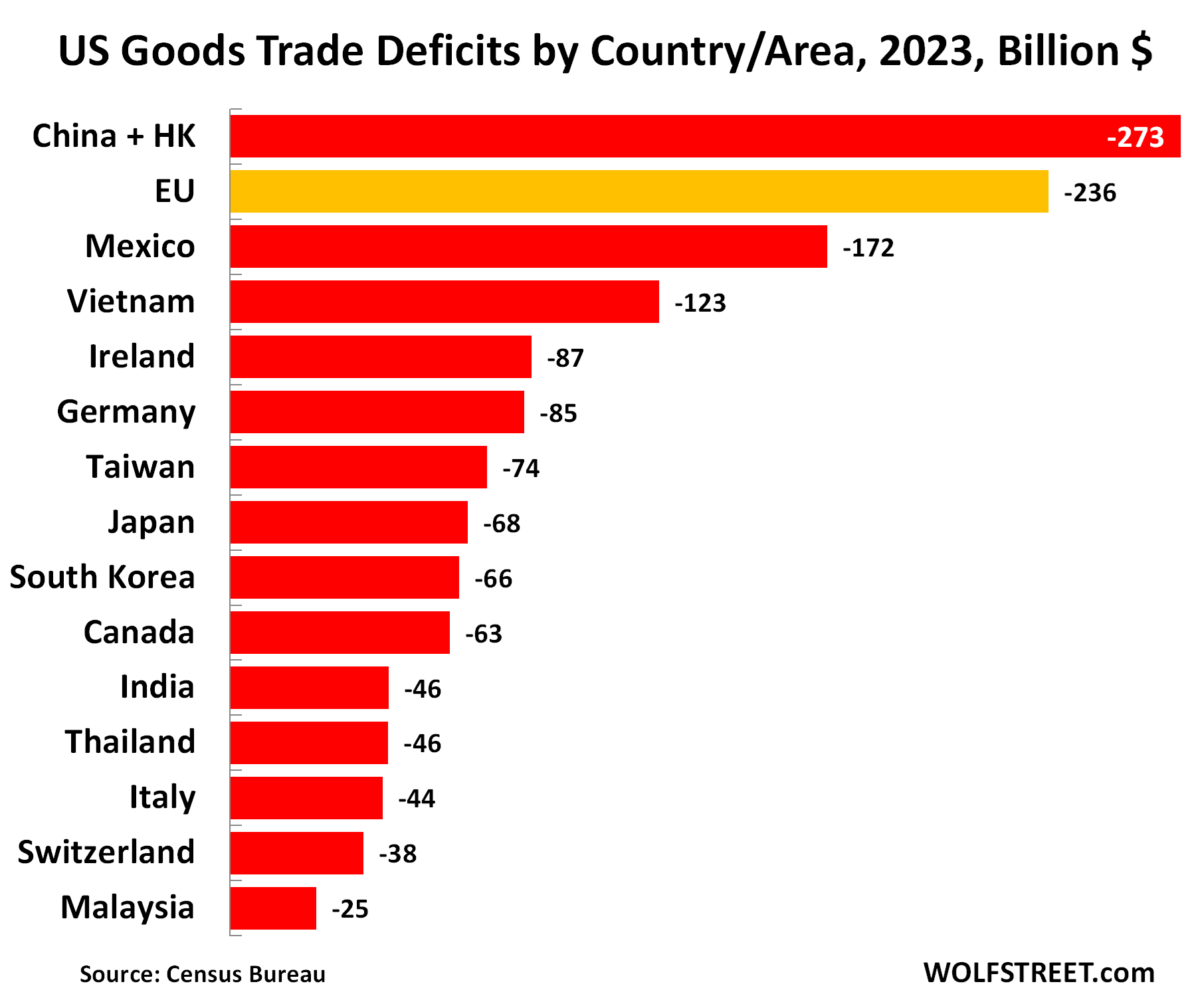
At some point over the next few days, I will dive into imports and exports by category of goods and services, which is fascinating, so stay tuned.
Meanwhile, the globalization-mongers hate tariffs because they’re a tax on the gross profit margins of the importers among Corporate America and hit stocks because passing that cost on to consumers in a competitive market isn’t easily possible. I watched it last time, amazed by the lack of inflation. Sure, “This time it’s different,” the four most costly words on Wall Street. Here are the details, including how tariffs actually work: What Trump’s Tariffs Did Last Time (2018-2019): No Impact on Inflation, Doubled Receipts from Customs Duties, and Hit Stocks
Enjoy reading WOLF STREET and want to support it? You can donate. I appreciate it immensely. Click on the beer and iced-tea mug to find out how:
Would you like to be notified via email when WOLF STREET publishes a new article? Sign up here.
![]()
The post Trade Deficit in Goods Worsens to All-Time Worst in 2024, Small Surplus in Services Rises, Overall Trade Deficit Worsens by 17% appeared first on Energy News Beat.
“}]]
Energy News Beat

